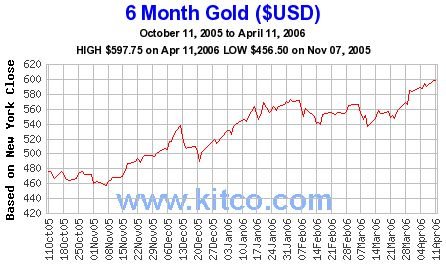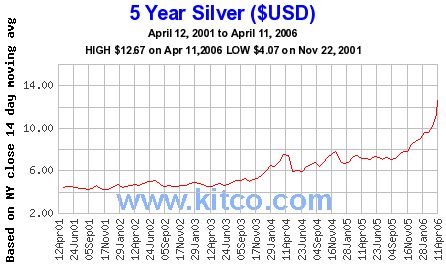The Money Is Here To Stay
Wednesday, April 12, 2006
It's hard to tell if the mainstream financial media is paying more or less attention today, as gold wages an assault on the $600 mark, than it did a few months back when, after repeated attempts, the $500 level was conquered, bringing consternation to economists and glee to gold bugs.
That was only four months ago.
Even Jethro Bodine of The Beverly Hillbillies fame, with his limited ciphering ability, could likely calculate the very impressive 20 percent gain in that short period of time (whether Jethro would be able to annualize the increase is another matter.) And then there's silver - on a longer term chart it appears to be going parabolic. Fewer people are talking about it in recent days as it seems no one wants to make a fool of themselves by trying to predict what's going to happen next.
And then there's silver - on a longer term chart it appears to be going parabolic. Fewer people are talking about it in recent days as it seems no one wants to make a fool of themselves by trying to predict what's going to happen next. Silver, today, is kind of like that hugely entertaining alcoholic uncle who delights family gatherings with jokes and stories. The crowd laughs so hard their eyes water and their bellies hurt, but all the while they wonder how the evening will end.
Silver, today, is kind of like that hugely entertaining alcoholic uncle who delights family gatherings with jokes and stories. The crowd laughs so hard their eyes water and their bellies hurt, but all the while they wonder how the evening will end.
They wonder whether the entertaining, but highly inebriated uncle will conclude his merriment and sleep safely and soundly somewhere, whether there will be trouble, or whether the party will just continue through the night.
The Rush of Investors
But, gold and silver have been late comers to the commodities party - it's been only in the last nine months that precious metals have heated up in a big way. Investors have noticed that oil, natural gas, base metals, and foodstuffs have been going gangbusters for a few years now, as noted in this story ($) from yesterday's Wall Street Journal.A stampede of mainstream investors into commodities is fueling gold's rally toward $600 an ounce and also could be driving up prices for oil and other raw materials.
From a total of $6 billion in institutional investment funds directed toward commodities in 1999, today's tally of over $100 billion and rising is a clear sign that the stigma once associated with investing in commodities is fading.
In a phenomenon that could still intensify, big institutions and everyday investors around the globe are adding commodities to their portfolios, hoping the bull market in natural resources will continue. Many of the newcomers are investors who use index-based strategies to, in effect, buy and hold in a field they previously found too complex and risky.
With prices that continue to confound many, and with more new ETF products available to make the whole process easier, it doesn't look like things are going to slow down much, any time soon.
And, why should they?
Investors of all types have discovered an asset class that has been mostly dormant for nearly two decades. Even Money Magazine has recommended a 10 percent allocation for precious metals. Why not make a commitment to commodities?Half of the pension funds, hedge funds and other institutional investors polled by Barclays in February said they had no commodities exposure in 2005. Most are now expanding their total commodities allocation between 1% and 10%. And because they want to diversify and use commodities as an inflation hedge, they may stay in commodities even if returns drop. (Some commodities index investments have dropped this year, mainly because of natural-gas price declines.) Roughly 40% expect to hold their commodities investments for three years or longer, and an additional 28% plan to sit tight for 18 months or more.
You hear all kinds of opinions these days, but the general tone is much different than a year ago. The rise in demand from Asia and the lack of investment in infrastructure and exploration in recent years have contributed to imbalances in supply and demand that can not be resolved quickly or easily.
"The market is quite secure that the money is here to stay," says Torsten de Santos, Barclays head of European Commodity Investor Solutions.
About the only thing that would surely derail the commodities boom is a global slowdown, a painful recession that policymakers and central banks of the world will do everything in their power to forestall.
Further on in the WSJ story we learn of a study that can be embraced wholeheartedly. The common perception of commodity investing is that it's too risky, but a Wharton School professor is set on debunking that theory.Gary Gorton -- a University of Pennsylvania Wharton School professor and the co-author of a study showing commodities have roughly returned the same as stocks over 45 years with less risk -- says the market is getting bigger now that it isn't considered so risky, but other economic forces are pushing the price up." Commodities futures is a very old asset class, and it has had a stigma. A lot of what we're seeing is just overcoming the stigma. That makes it a bigger market, but does not necessarily make prices go up," he says.
Hmmm... the same return as stocks but with less risk - over a forty-five year period. That's good to know.
And finally, the discussion turns to everyone's favorite drunk uncle.An April 3 report by J.P. Morgan Chase & Co. predicts that silver is in for a correction after mania subsides about the new exchange-traded fund. Analyst Anindya Mohinta points to what happened to gold prices when gold ETFs were launched. Prices rose as much as 12% in the 90 days before the launch, then fell by 7% to 10% in the 90 days after.
There they go with a prediction, but not a very bold one - a "correction". There are corrections about every third day in the price of silver - no, make that every third hour. It's the magnitude and the duration of a correction that people are wondering about.
Barclays expects demand for its silver ETA to require the purchase of 130 million ounces of silver, or 12% of the global silver demand. Mr. Mohinta says that could produce a short-term, "bubble-like impact" on silver's spot market.
But, people wondering about the price of silver should be reminded that this is 2006, not 2004 - there's a big difference.











![[Most Recent Quotes from www.kitco.com]](http://kitconet.com/charts/metals/gold/t24_au_en_usoz_2.gif)
![[Most Recent Quotes from www.kitco.com]](http://kitconet.com/charts/metals/silver/t24_ag_en_usoz_2.gif)
![[Most Recent USD from www.kitco.com]](http://www.weblinks247.com/indexes/idx24_usd_en_2.gif)

7 comments:
Tim,
I think the case for PMs is made. However, being a foreigner in your country, it is very apparent to me that the tax code discourages US citizens and residents from holding PMs as an asset class. This confers an enormous advantage upon foreign-based PM buyers competing for the same prize. In many countries, taxes on PM 'gains' are either much lower or entirely non-existent. The end result? I would not be at all surprised to find that, when currency crisis comes to pass, Indian grandmothers could very likely surpass McMansion McMillionaires in real wealth.
Re: About the only thing that would surely derail the commodities boom is a global slowdown
Counterpoint:
(1) A significant global slowdown would collapse the debt pyramid and trigger a flight to hard assets.
(2) Decades of capital misallocation and malinvestment have created supply and reserve shortages in many commodities. Demand may recede in a global slowdown but it will not go to zero. In many cases, demand is inelastic. Increasingly, supply, not demand, is responsible for driving prices up.
(1) + (2) = commodity prices will not collapse and are even more likely to go up in a global deflationary depression.
Anon 9:00 AM,
If U.S. citizens buy the gold or silver ETFs from a brokerage account inside of an IRA (individual retirement account), the 28% collectible tax can be avoided - from a tax standpoint, that's probably the best way to do it. This detracts little, however, from the merits of your Indian grandmother / McMansion McMillionaires prediction.
bullion and the ETFs that hold bullion are two very different things when it comes to taxes, since the ETF leaves a clear paper trail, whereas gold coins can disappear and reappear without uncle sam being any the wiser
What happens if you try to buy a house with bullion?
Some tax rate comps here:
http://www.accf.org/publications/reports/sr-intcomparisoncap1998.html
Note the countries with low or exempt cap gains taxes.
I've often wondered if you could buy a house with American Gold Eagles - they're stamped with Fifty Dollars right on the face, so I think they're legal tender.
Could you arrange to buy a $600,000 home with 1,000 one ounce coins?
Who pays what taxes?
pundits just don't understand and won't understand it because they talk stocks and bonds. channels like CNBC and other business shows are all about stocks. they don't know what to do when gold goes up. someday they'll realize that gold going up means their stocks will go down. however, the entire financial industry is paper, not gold. when they finally understand gold it will be at a much higher price. it will be after stocks have gotten hammered. when they buy, that's just about when a correction will happen. this will be the last wall of worry before liftoff.
even in some the articles I read about commodities they are half-negative. they talk about "not chasing the hot thing." they talk about not making gold anything more than a miniscule part of your portfolio.
can you imagine a mainstream financial guy recommending you buy silver bars or corn futures? they only know how to recommend stocks.
THAT'S THE WAY IT HAS TO BE FOR A BULL TO BEGIN!
Post a Comment